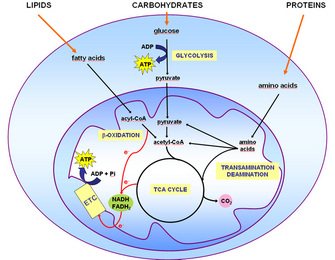How do you think the activity of other metabolic pathways might change in response. Examples of Metabolic Pathways are many.

Nutrient Metabolism Human Learn Science At Scitable
As illustrated in Figure 1-1 the aerobic pathway produces large amounts of energy albeit it more slowly and can utilize all three macronutrients as a fuel source.

. Glycolysis - occurs in the cytoplasm. Phosphoryation of ERK2 on Threonine 183 Thr153 and Tyrosine 185 Tyr185 leads to a structural change in the protein and the regulation of its activity. Metabolic Pathway 1.
Extracellular regulated kinase 2 ERK2 also known as mitogen activate protein kinase 2 MAPK2 is a protein the plays a vital role in cell signaling across the cell membrane. Aerobic glycolysis has a slow rate of ATP production and is predominantly utilized during longer-duration lower-intensity activities after the phosphagen and anaerobic systems have fatigued. For example CO is still being generated by the pyruvate dehydrogenase or PDH complex and the citric acid cycle but less ATP is being generated for each molecule of pyruvate used.
In addition to the two distinct metabolic pathways is the amphibolic pathway which can be either catabolic or anabolic based on the need for or the availability of energy. During any given day your metabolism switches between absorptive and postabsorptive states. The metabolic pathways chart is a tool that is used to view how the different metabolic pathways are connected to each other.
There are three main metabolic states of the body. In eukaryotes the metabolic pathways occur within the cytosol and mitochondria of cells with the utilisation of glucose or fatty acids providing the majority of cellular energy in animals. A metabolic pathway is a step-by-step series of interconnected biochemical reactions that convert a substrate molecule or molecules through a series of metabolic intermediates eventually yielding a final product or products.
While enzymes in catabolic pathways break down molecules and. Tricarboxylic Acid Cycle 5. Oxidative pathways include glycolysis the tricarboxylic acid cycle aka Krebs cycle and mitochondrial oxidative phosphorylationelectron transport.
Example- Amino acids can be used to build protein carbon dioxide and can be used to make sugar. It is important to learn from the chart to gain a better understanding. Absorptive fed postabsorptive fasting and starvation.
The glycogen in muscle is not being actively broken down for energy until significant muscle work is required when it provides glucose for glycolysis and aerobic energy metabolism. 7 Pathways are required for the maintenance of homeostasis within an organism and the flux of metabolites through a pathway is regulated depending on the needs of the cell and the availability of the substrate. The catabolic pathway helps to create energy for various activities.
Note that every stage of glucose catabolism is still occurring. The following points highlight the five major pathways in organisms. Pentose Phosphate Pathway 3.
- these pathways break molecules down oxidative pathways - carbs proteins lipids break down into their monomers and catabolicoxidize down to CO2 and water. The process of glycolysis is used to create energy via the catabolic pathway. Energy released from oxidative reactions is used to produce molecules like ATP as well as heat.
Enzymes in the anabolic pathway or biosynthetic process need the energy to change or convert molecules into more complex molecules or macromolecules. Mevalonic acid pathway etc. Metabolism is organised into distinct metabolic pathways to either maximise the capture of energy or minimise its use.
Energy to fuel biological work is produced aerobically in the presence of oxygen or anaerobically in the absence of oxygen 1. Denova synthesis 10. - these pathways build molecules.
The processes of making and breaking down carbohydrate molecules illustrate two types of metabolic pathways. Coenzyme NAD Accepts hydrogens and electrons in metabolic pathways and FAD accept hydrogen in metabolic pathways amino acids deamination amino acids is deamination before using it as a fuel molecule This means removing the amino group by either releasing it to the solution or transferring it to other molecule leaving carbon skeleton which are used as a fuel. The oxygen deficit is the difference between the volume of oxygen consumed during exercise and the amount that would be consumed if energy demands were met through only the aerobic energy pathway.
Citric acid cycle - occurs in the matrix of the mitochondria. Adipose tissue doesnt do much metabolically in the body at rest and not actively digesting a recent meal. The rest interval or active-recovery period during an anaerobic workout allows aerobic metabolism to produce and replace ATP in the involved muscles.
This pathway occurs in the mitochondria of the cell and is used for activities requiring sustained energy production. Starvation states happen very rarely in generally well-nourished individuals. The metabolic pathway involved in respiration can be split into three main parts.

Nutrient Metabolism Human Learn Science At Scitable

Tj Glycolysis From Glycose An Older Term For Glucose Lysis Degradation Is The Metabolic Pathway That Conver Medical Student Study Biochemistry Chemistry
0 Comments